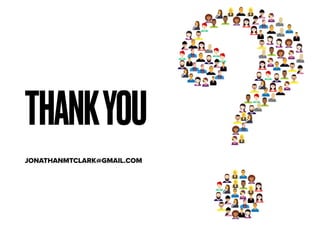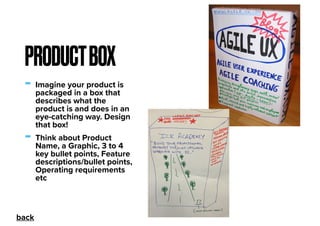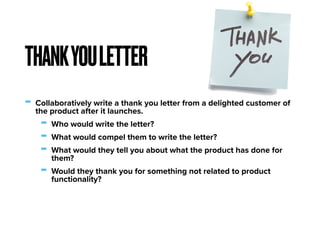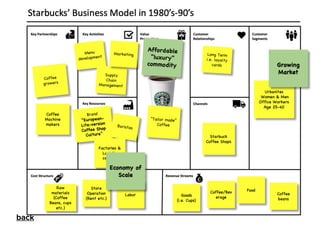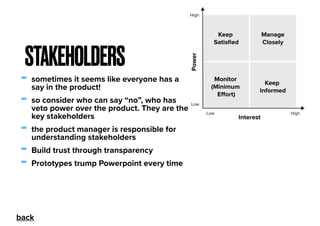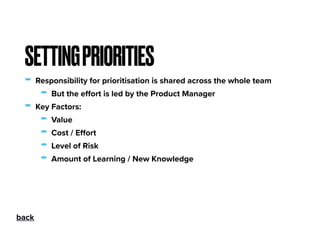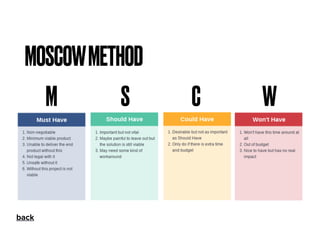Clark "Understanding Needs & Setting Priorities: Product Discovery"
- 2. RECAPWHAT QUESTIONS DO YOU HAVE ARISING FROM THE SESSIONS SO FAR?
- 3. TODAYWHAT QUESTIONS DO YOU HAVE ABOUT AGILE PRODUCT DISCOVERY?
- 4. what is product discovery? what’s different about agile discovery? who is involved in product discovery? how much time should we spend on investigating problem vs the solution? do I need a product vision? what is dual-track agile? what is a problem definition? what are hidden insights? who sets priorities? how do you prioritise markets?how to prioritise for risk? what is story mapping? how does Kano model help set priorities? is there a simple way to do product prioritisation? what is the MoSCoW method? what’s a good technique for discovering new features? what are good tools for product vision? what is a good tool for getting clarity on product vision? what’s a good way to understand the customer? product discovery: where do I start? is a discovery sprint a good idea? who are my stakeholders? what is a prototype?
- 5. Product Manager The Agile Team
- 7. - Focus on building the right thing (vs building the thing right) - The right product for the right audience - Products - that matter - that people want - that are easy to use - we can build - that we should build - Look for evidence - collect facts and not opinions - Validate your ideas during discovery not after PRODUCTDISCOVERY back
- 8. - Traditionally product discovery was project “pre-work” - In today’s world that’s not good enough - user needs change and evolve over time - technology capabilities change over time - ideas emerge anytime, not just at the start - the best solutions evolve over time - So we need an iterative “inspect & adapt” process AGILEPRODUCTDISCOVERY understand ideas test adapt prototype back
- 9. - The agile team must discover & learn together - They must have seen the customer’s pain together - They must all have fallen in love with the problem - They have explored possible solutions together - They must all understand the vision for the product BUT - Wouldn’t the developers’ time be better spent coding? - A tricky trade-off ALLABOUTSHAREDLEARNING back
- 10. - Product discovery should mostly be about the problem space - Problem prioritisation - which problem will we solve? - Problem definition - do we truly understand the problem? - We cannot rely on customers to tell us what to build - We need to look for the underlying problems - Jobs to be Done, Pains & Gains - Fall in love with the problem, not the solution! - Tell stories about the problem PROBLEMSVSSOLUTIONS back
- 11. - How the future will be as a result of our actions - Inspires the team (and the stakeholders) - Helps the team fall in love with the problem - Describes the purpose and the plan - Answers the “why are we doing this?” question - Is an ambitious leap of faith - Stories are good, they help people share the vision PRODUCTVISION back
- 12. - Discovery track - Conduct stakeholder interviews - Develop personas and user stories - Perform market research (surveys, user interviews, etc.) - Move items validated through this process onto backlog - Delivery track - Build prototypes - Conduct iterative user testing - Apply user feedback to product updates DUAL-TRACKAGILE DUAL-TRACK not DUEL-TRACK! back
- 13. A problem definition states the design objective in one or two clear, concise sentences PROBLEMDEFINITION back
- 15. Discovering insights you have not already got WHEELOFNOT back
- 16. - experiments to quickly and cheaply test your thinking - many techniques, one golden rule: it has to have realness - typically prototypes test for: - value - usability - feasibility - viability - Fidelity: how realistic the prototype looks & feels PROTOTYPES back
- 17. - Imagine your product is packaged in a box that describes what the product is and does in an eye-catching way. Design that box! - Think about Product Name, a Graphic, 3 to 4 key bullet points, Feature descriptions/bullet points, Operating requirements etc PRODUCTBOX back
- 18. - Collaboratively write a thank you letter from a delighted customer of the product after it launches. - Who would write the letter? - What would compel them to write the letter? - What would they tell you about what the product has done for them? - Would they thank you for something not related to product functionality? THANKYOULETTER
- 19. - Collaboratively write the press release you’d like to see published at the product launch - What are the key points you’d make about the product? - What quotes would you have and who would they be from? CEO? Team members? Customers? PRESSRELEASE The _______company announced today the successful completion of the _________project. This project provides ___________________ _______________________________. The customer for this project, ________________, indicated in a recent interview that they selected ___________ as their supplier due to the following key benefits: 1. ______________________________________ 2. ______________________________________ 3. ______________________________________ ________________ also identified several features that they felt were particularly useful. These include: 1. ______________________________________ 2. ______________________________________ 3. ______________________________________ ____________ noted that the single most important benefit of their successful project was “__________________________________ _____________________________________.”
- 20. - Imagine your product is packaged in a box that describes what the product is and does in an eye-catching way. Design that box! - Think about Product Name, a Graphic, 3 to 4 key bullet points, Feature descriptions/bullet points, Operating requirements etc PRODUCTBOX back
- 21. ELEVATORPITCH A vision for the proposed product that is simple and compelling enough to be delivered to a stakeholder while they are in an elevator (or waiting for an Uber to arrive.) Structure is: For (target customer) Who (statement of need or opportunity) The (product name) is a (product category) That (key benefit, compelling reason to buy) Unlike (primary competitive alternative) Our Product (statement of primary differentiation) For householders who want to clean their carpets, a Dyson is a vacuum cleaner that uses a unique internal cyclone mechanism. Unlike all other vacuum cleaners, our product does not require a bag, and so never loses suction. Example back
- 22. - Empathy Maps are useful in exploring users & customers and to understand their pains (obstacles, challenges) and their gains (needs, wants and successes) - You can use empathy maps with real users and customers! Just invite them in for an hour or so and in groups of 5-8 have them completely fill a poster with their insights. Make sure you leave enough time to clarify what they have written so that it is all clear to you, in particular the pains and gains EMPATHYMAP THINK&AND&FEEL? SEE? SAY&AND&DO? HEAR? PAIN? GAIN? What%does%the%Customer What%does%the%Customer What%does%the%Customer What%does%the%Customer Environment,%friends,%colleagues What%is%important? What%are%their%hopes,%dreams,%fears? What%influences%the%customer? What%obstacles%and%challenges? Needs%and%wants,%measures%of%success back
- 23. - Simple templates that help you ask the right questions - Good way to identify where the key assumptions and major risks are - It’s a one-pager! - Great for collaborative group work - Plenty of examples online - startup canvas - lean canvas - business model canvas - Value proposition canvas can be especially helpful CANVASTECHNIQUES
- 27. back
- 28. - one week time box of product discovery - Day 1 – Identify the challenge to be addressed and gather expert opinion - Day 2 – Review existing solutions and sketch potential ideas - Day 2 – Decide which ideas to progress, produce a storyboard for the prototype - Day 4 – Produce the prototype - Day 5 – Customers evaluate the prototypes - a.k.a. design sprints - good for dealing with a big challenge or risk BUT - can be a “snake oil” remedy - use a discovery coach! DISCOVERYSPRINTS back
- 29. - sometimes it seems like everyone has a say in the product! - so consider who can say “no”, who has veto power over the product. They are the key stakeholders - the product manager is responsible for understanding stakeholders - Build trust through transparency - Prototypes trump Powerpoint every time STAKEHOLDERS back
- 30. - Responsibility for prioritisation is shared across the whole team - But the effort is led by the Product Manager - Key Factors: - Value - Cost / Effort - Level of Risk - Amount of Learning / New Knowledge SETTINGPRIORITIES back
- 31. - Total Addressable Market (TAM) - how big is the market for your product? - how large is the revenue opportunity? - Go To Market (GTM) - how will you distribute your product? - which sales and marketing channels? - Time to Market (TTM) - roughly how long will it take until it’s available for sale? PRIORITISINGMARKETS back
- 32. MOSCOWMETHOD M S C W back
- 33. RISK/VALUE High risk Low Value High risk High Value Low risk Low Value Low risk High Value Avoid Do first Do last Do second Risk Risk Value ValueLow LowHigh High High HighLow Low back
- 35. KANOMODEL High Low CustomerSatisfaction Feature PresenceAbsent Fully Implemented Perform ance /linear Exciters and delighters Must-have, mandatory back
- 36. - This simple approach to prioritisation involves taking your list of features and initiatives and quantifying them using value and effort scores. VALUEVSEFFORT back





